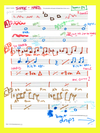This Compilation Is a Dream
Four months after the invented genre “hit ’em” first hit, a new benefit compilation chronicles a sound that sprung from one man’s subconscious.

At a time when good fun can be hard to come by, in music or otherwise, the ongoing saga of hit ’em has been a rare unalloyed delight. If you’re just catching up: Back in July, Drew Daniel—a wonderful electronic musician and writer who you might know as one half of Matmos or the guy behind the Soft Pink Truth—tweeted about a dream he had. He was at a rave, and a girl was telling him about the parameters of a genre called “hit ’em”: “5/4 time at 212 bpm with super crunched out sounds.” The tweet blew up, and people started taking it as a prompt, making tracks that conformed to the rules the dream girl laid out. Hit ’em became an actual genre of sorts. Daniel’s dream came true.





